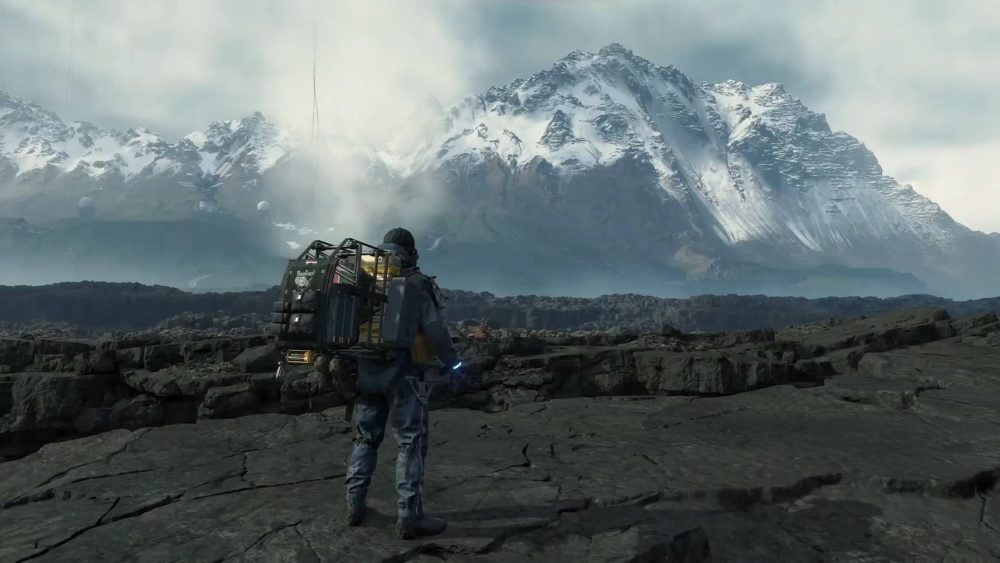
I don’t really know how to review a game like Death Stranding. Try as I might to collect my thoughts for review, it seems designed to defy critical appraisal at every turn. This may make it a work of high and complex art, a kind of long-form interactive Rorschach test, but I don’t know that it makes for a terribly exciting video game. Then again, by the very nature of high and complex art, Death Stranding will be different things to different people. What may seem like thinly-veiled anime waffle to me might be a profound and moving experience to you, and neither take is more or less correct than the other.
Reedus a story
Death Stranding is set in the years following a massive crisis within the United States. An event called the Death Stranding has rendered the previously simple act of dying a terrifying, explosive event. When a person dies, there is a short period of time in which their body can be cremated before a process called Necrosis sets in. When a body Necrotises, becomes an ichorous, oil-like black substance, transubstantiating into an invisible, spectral monster referred to as a BT. The transformation is codified with an explosion, one large enough to level large, heavily populated areas, leaving a giant crater in its wake. This process is called a Void Out.
BT’s can appear at any time, ruthlessly murdering anyone unfortuante enough to be in their way. They are most likely to appear during a storm and are heralded by an inverted rainbow in the sky. When the storm arrives, a deadly rain called timefall begins. Each raindrop causes any living thing it touches to wither and age in seconds. Being technically already dead, and maybe existing in a different dimension (???), BT’s are unaffected by the timefall and stalk their prey as they attempt to flee through it.
The Death Stranding has severed human communication and connectivity across the continental US. There’s no internet, no dedicated phone lines. Every city is self-contained – referred to as Knots, these cities are all part of a longer thread but remain separate from any sort of whole. Running between these cities, delivering supplies, are Porters.
Standard American Male
You are Sam Porter, one of many Porters charged with delivering packages safely between cities. For much of the early game, you perform this task on foot, trudging across the jagged, mountainous countryside from outpost to outpost. Sam is an unhappy man. A loner by nature, life as a Porter works for him. It keeps him isolated and, to him, justifies his unfriendly demeanour.
A key component in all of this is Sam’s severe aphenphosmphobia, a fear of being touched. It’s a character trait that serves two purposes — it reinforces his isolation in case it wasn’t already clear enough, and indulges Kojima’s favourite trope of deploying terms like aphenphosemphobia, words that no-one has ever spoken aloud, as though they’re perfectly normal.
Sam is played by Norman Reedus, Kojima’s muse of the moment, and he plays the role to the hilt. Sam is a bog-standard American action hero — blunt, reluctant, unemotional, and kind of dumb but also capable of solving any problem. I can’t say that I like Sam, or even relate to him, but I don’t know that that’s the point. Given the game’s constant focus on connection and his extreme distaste for the same, I think you’re supposed to dislike Sam. I think you’re supposed to yearn for connection and resent him for keeping it at arm’s length. Again, this just is my interpretation. Yours may be very different.
Sam is quickly recruited by the Bridges company, who are trying to restore connectivity between the different Knot cities. Connecting cities to the Bridges network allows for a great many things — electricity and internet, the ability to transfer resources between settlements and create new infrastructure. Bridges can also use the data they gather from each settlement to assist them directly. New additions to the network can also use Bridges facilities to 3D print supplies and tools they need to improve their standard of living.
Reel-to-reel
There are aspects of Death Stranding that feel very much like A Hideo Kojima Game and aspects that don’t. Where it feels most like a Kojima joint are the cutscenes, which remain as long, detailed and lovingly photographed as ever.
There’s a staggering around of world-building information to be conveyed and, to the team’s credit, every cutscene tries to provide as much of it as possible. For those who tire of long, exposition-heavy cinematics, you don’t have much to look forward to in the game’s first few hours. There’s so much information to get across, and it’s not that the concepts are bad as much as their delivery.
Kojima’s typically heavy-handed scriptwriting becomes a cudgel, beating the player over the head with it’s messaging. Somewhat ironically, it feels as if Kojima is worried you might not connect the symbolic dots and so, in his desperation to be understood, abandons subtlety entirely. Hideo, mate, we get it. Relax.
The long and lonesome road
The thing that’s going to surprise most players about Death Stranding is that its primary game loop is simply retrieving and delivering packages. Maligned as the lazy game designer’s solution to padding out total playtime, Death Stranding makes the humble, monotonous fetch quest part of its identity.
Helping Sam navigate the world with a teetering stack of packages on his back is the kind of task that ensures a reaction from the player. You will either find an odd inner peace in the journey or be driven mad by the dreariness of the task.
Infrastructural changes are the biggest part of bringing new cities online. You and other Death Stranding players are working together to complete highways between cities, contributing resources to strengthen the bond and speed up the construction process. A completed highway is worth its weight in gold — you can load up a truck with deliveries, many more than you could carry on your back, and run them straight to the recipient without a hassle.
Along the way, you’ll need to place and use tools to move forward. Ladders are used to cross streams or rocky chasms. Ropes and climbing gear are used to rappel down sheer cliffs. The equipment you place may appear in another player’s game, and their equipment in yours. You can reward that player for their assistance by giving them Likes, the game’s sole currency, the only one that could possibly matter in an unconnected world.
These, and many other gameplay tools, only open up once you reach the game’s third episode. It’s worth pushing through to this point as it really does feel like Episode 3 is where Sam is freed of the early hinterlands biome and the game truly begins.
The green post-apocalypse
It must be said that the implementation of Reedus’ likeness into the game is one of its most remarkable feats. There are few dips into the uncanny valley, and the moments when he looks directly into the camera at the viewer trigger a visceral response in the player — it feels as though he really did just see you.
Death Stranding runs on Kojima Productions’ Fox Engine, the same one used to create Metal Gear Solid V which gives it a sense of familiarity. Character models and item interactions all feel very reminiscent of MGSV, as does much of the UI design. There may be some initial confusion over how exactly you deliver your packages — complete and partial deliveries are held under the same heading.
Environments are quite beautiful but never feel quite like you’re actually in the United States. The early area, in particular, reminds of Scotland or Ireland, green and mossy, covered in cruelly pointed black rocks. There’s still few engines in the world that can make a cliff face look this pretty though.
Enemies are genuinely terrifying and range from the horrifying, oily BT’s to the lawless squatters that lie in wait for unwary Porters. Seeing them come running out of the hills toward you as you try to get your delivery truck out of a bog is genuinely scary. Your cargo is precious and they’ll take it all.
Final thoughts
It’s hard to know what to make of Death Stranding. I don’t know that it’s the revolutionary experience its marketing made it out to be. I don’t even know that we’ll even remember it in five years. I am glad that a publisher with Sony’s prestige is willing to gamble on a passion project this weird. I have to wonder if they would have gone for it were Kojima were not attached, but I’m glad they did.
One thing is for sure: you will feel some kind of way about Death Stranding, a feeling that is uniquely your own. I don’t think I can even give Death Stranding a typical star rating, because it does everything it can to defy a review system like that. And I think that’s entirely the point.




Four Hideo Kojimas (Out of Five)
Highlights: Bold vision; Crazy worldbuilding; A Very Kojima Joint
Lowlights: Core delivery mechanic has a 50/50 likelihood of driving you mad
Developer: Kojima Productions
Publisher: Sony Interactive Entertainment
Platforms: PlayStation 4, Windows PC
Available: Now (PS4), Soon (PC)
Review conducted using a retail code provided by the publisher.de
